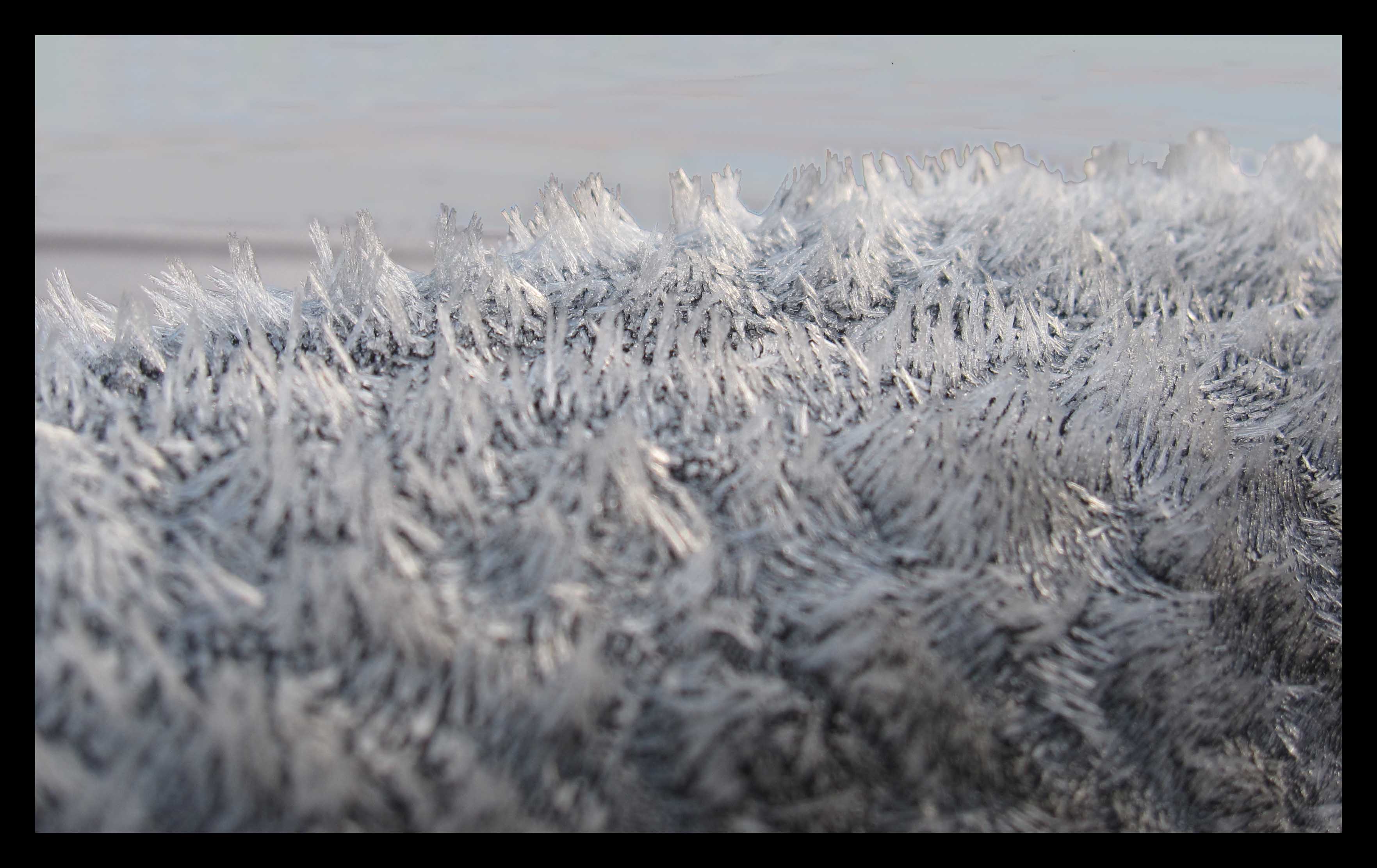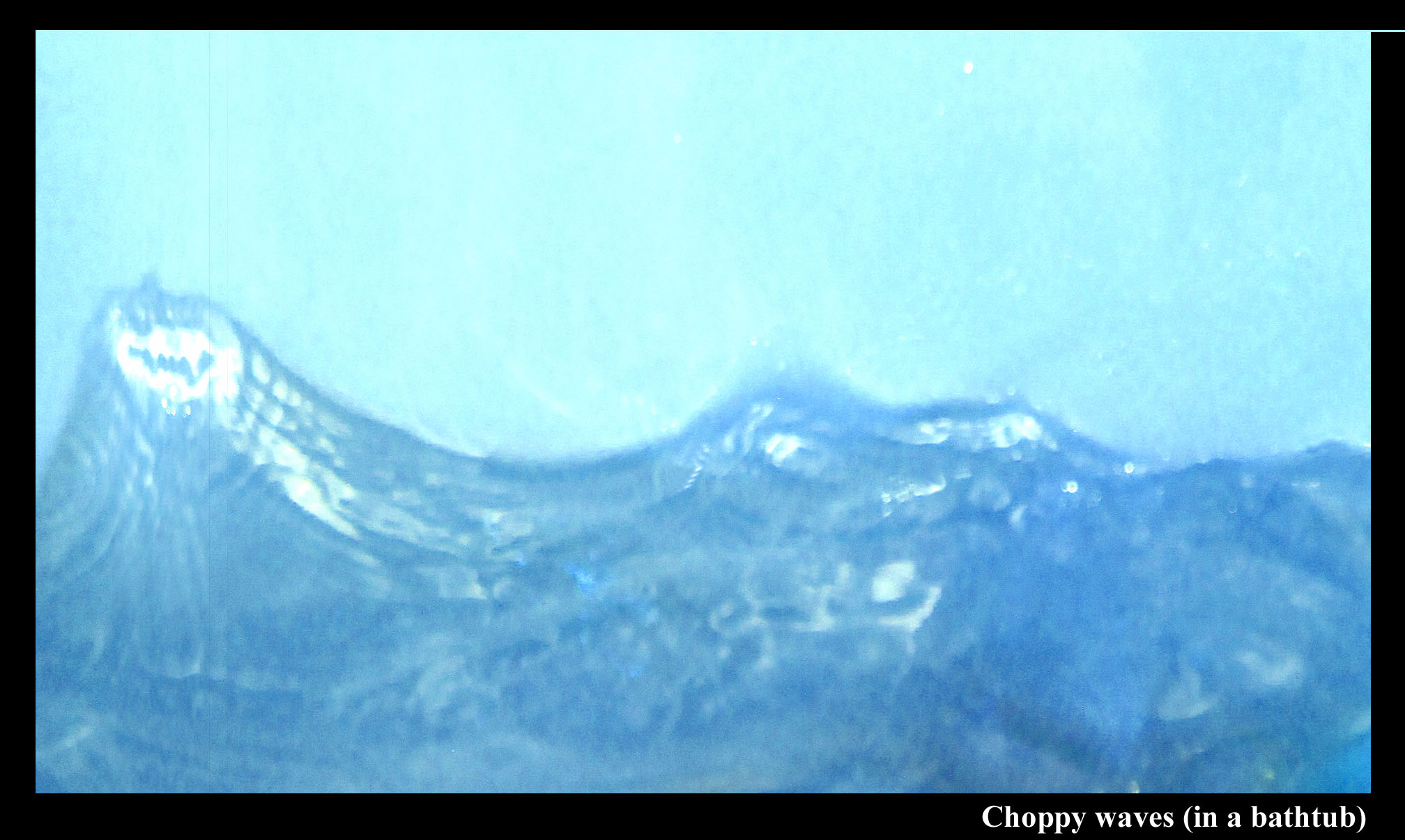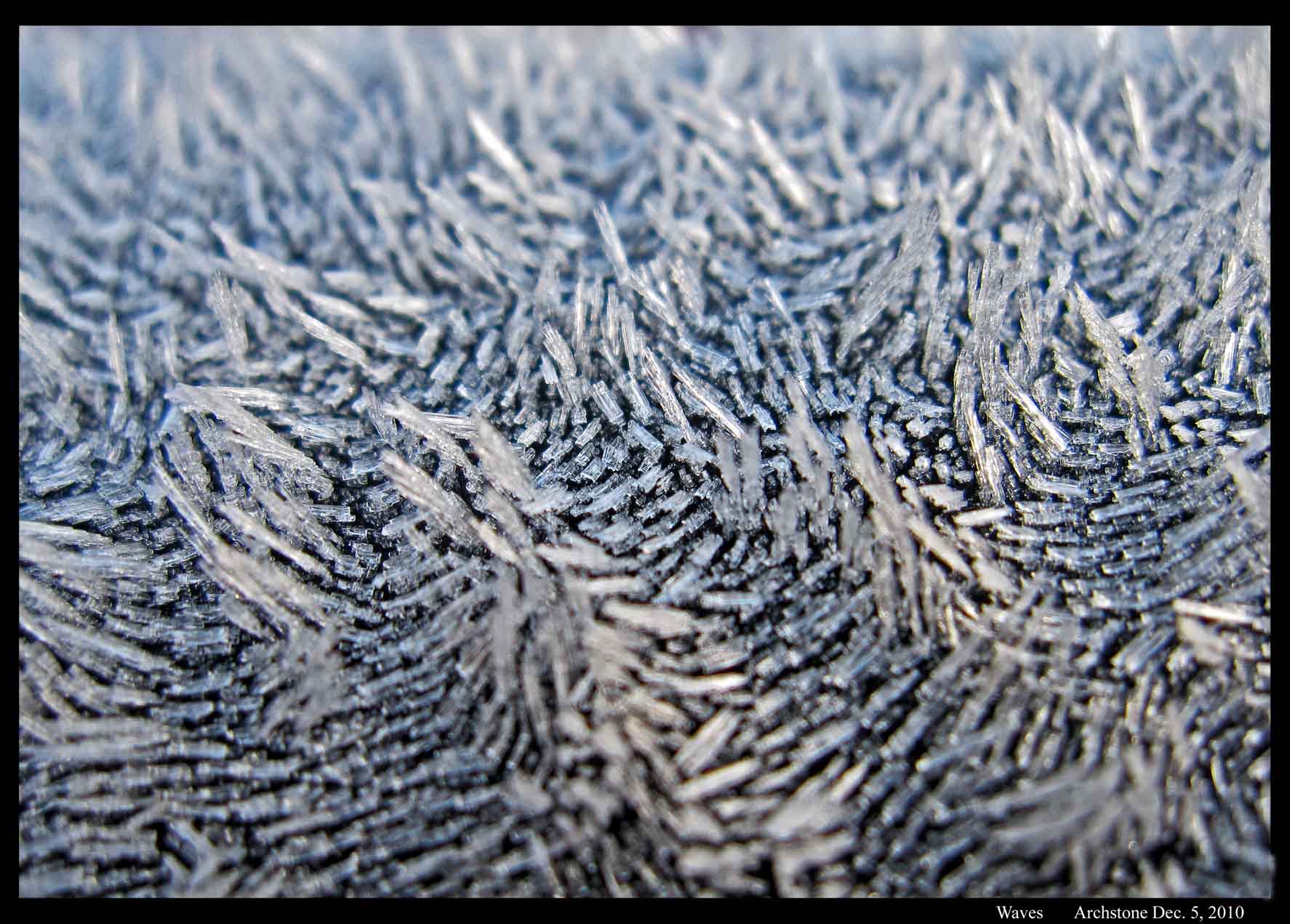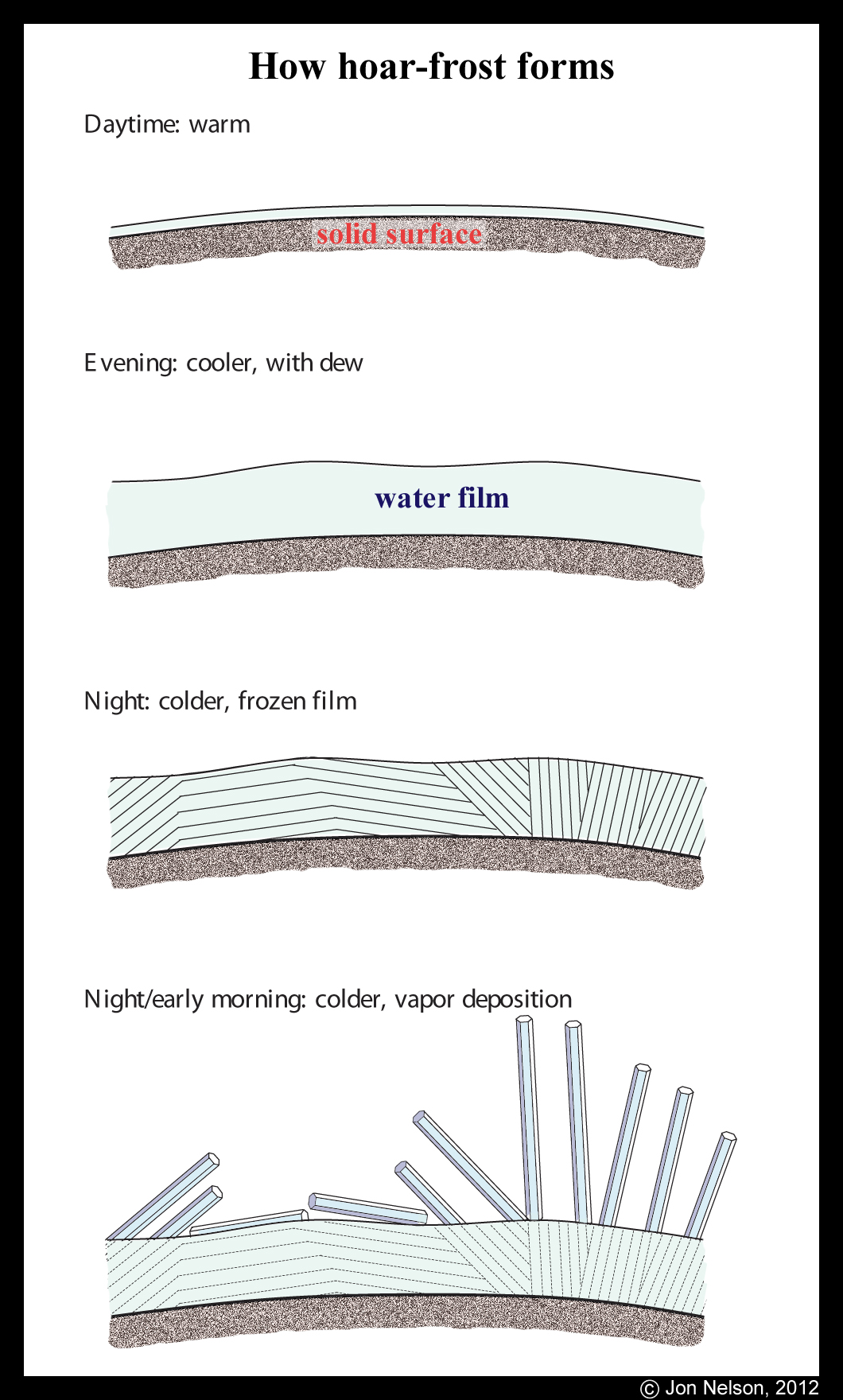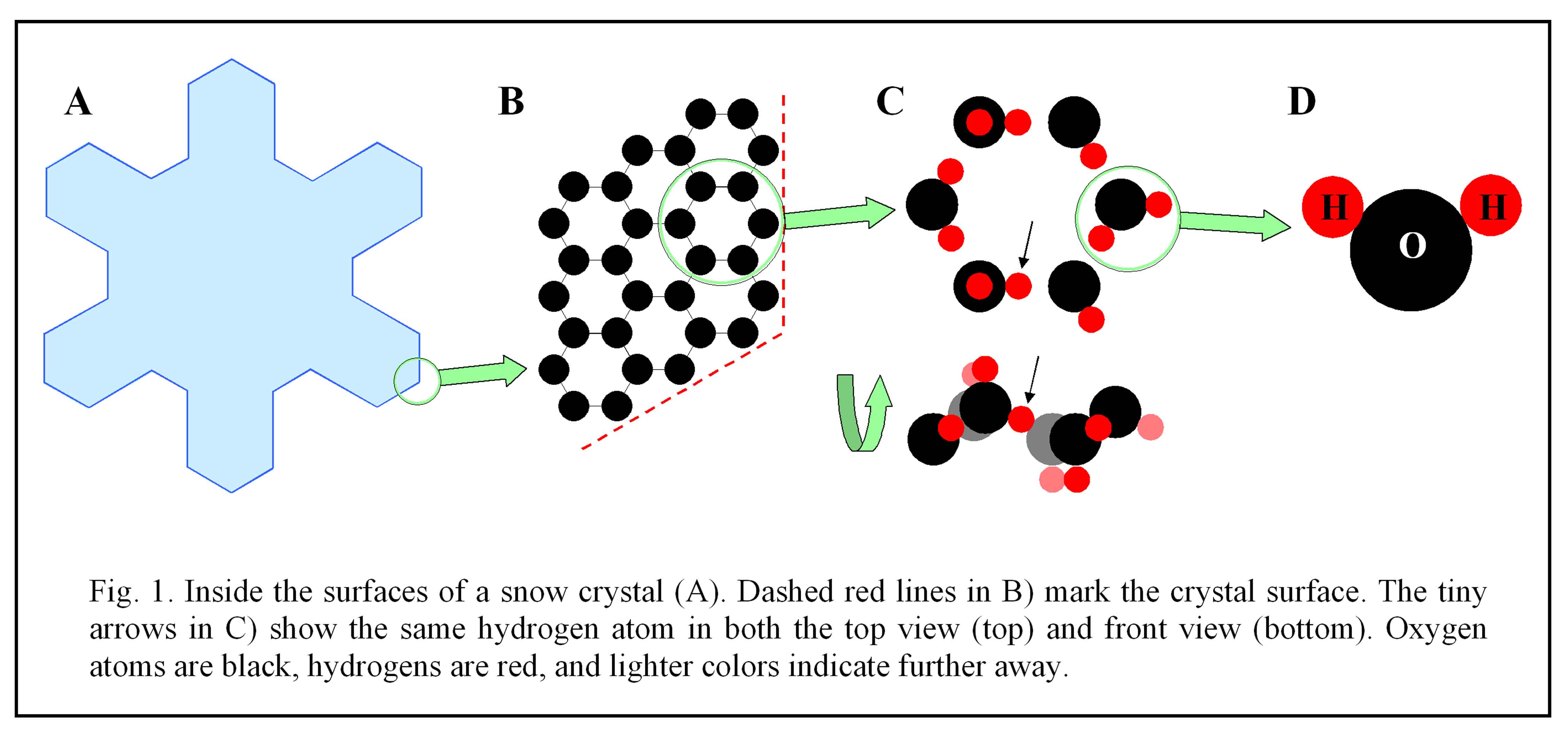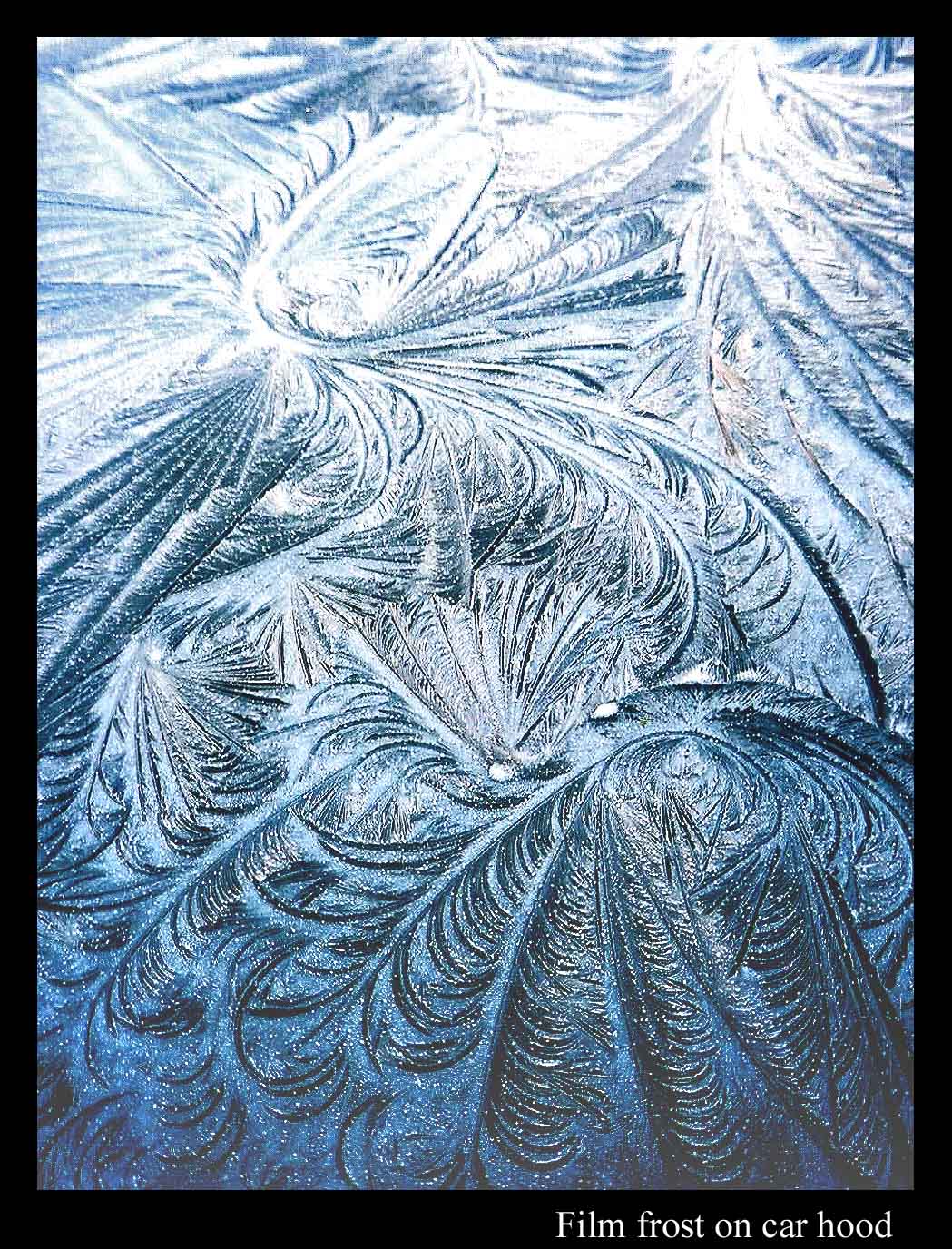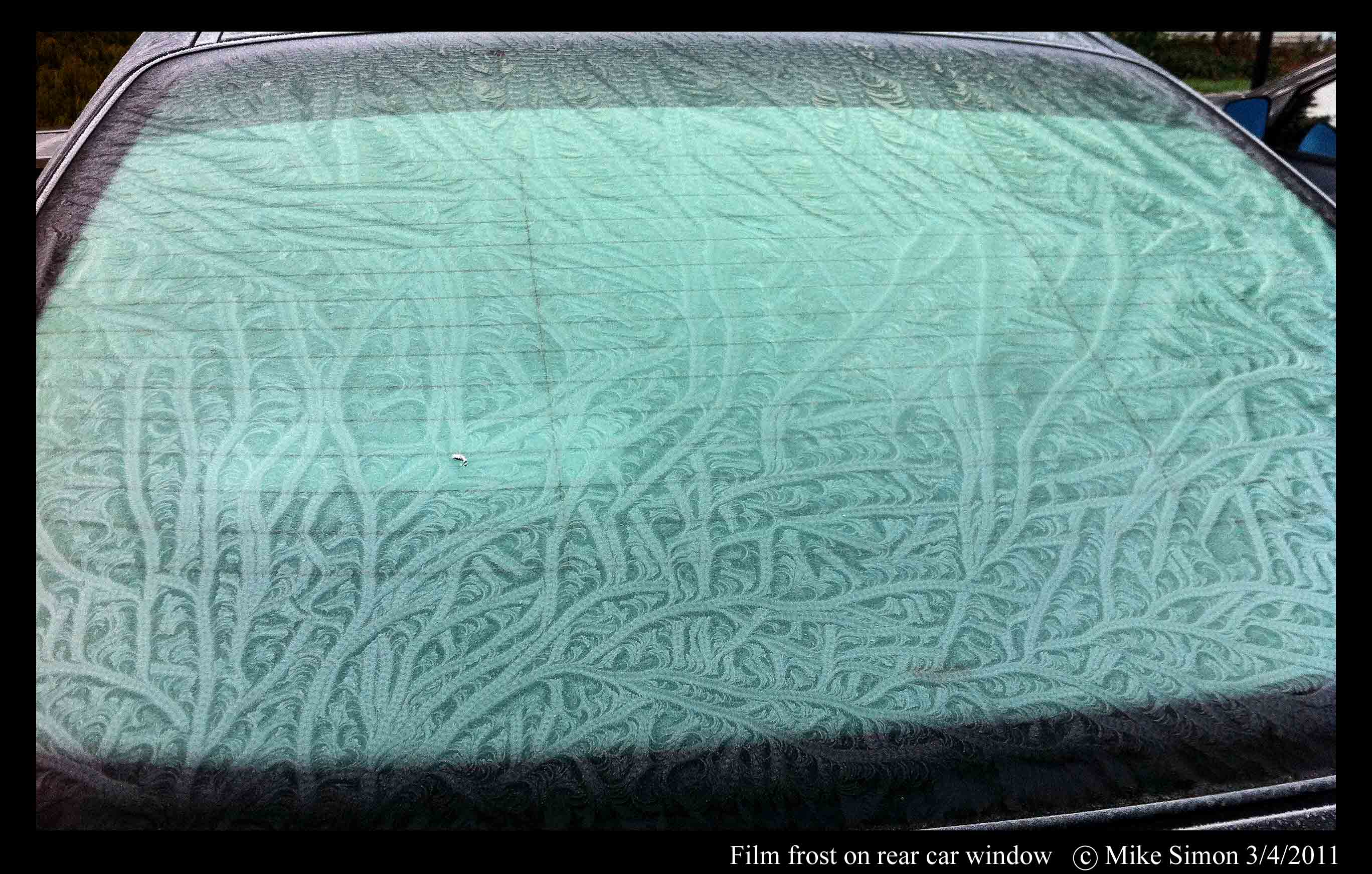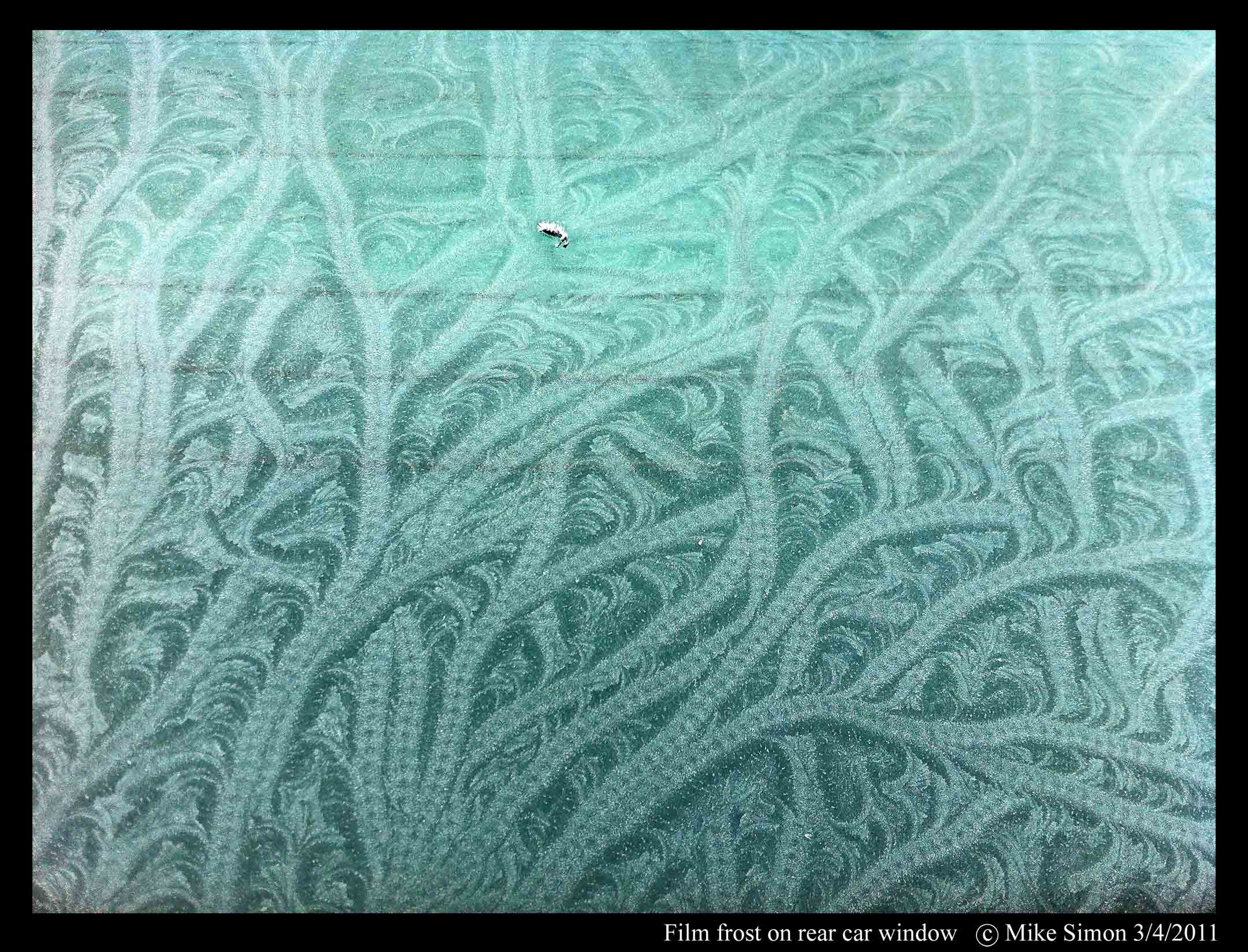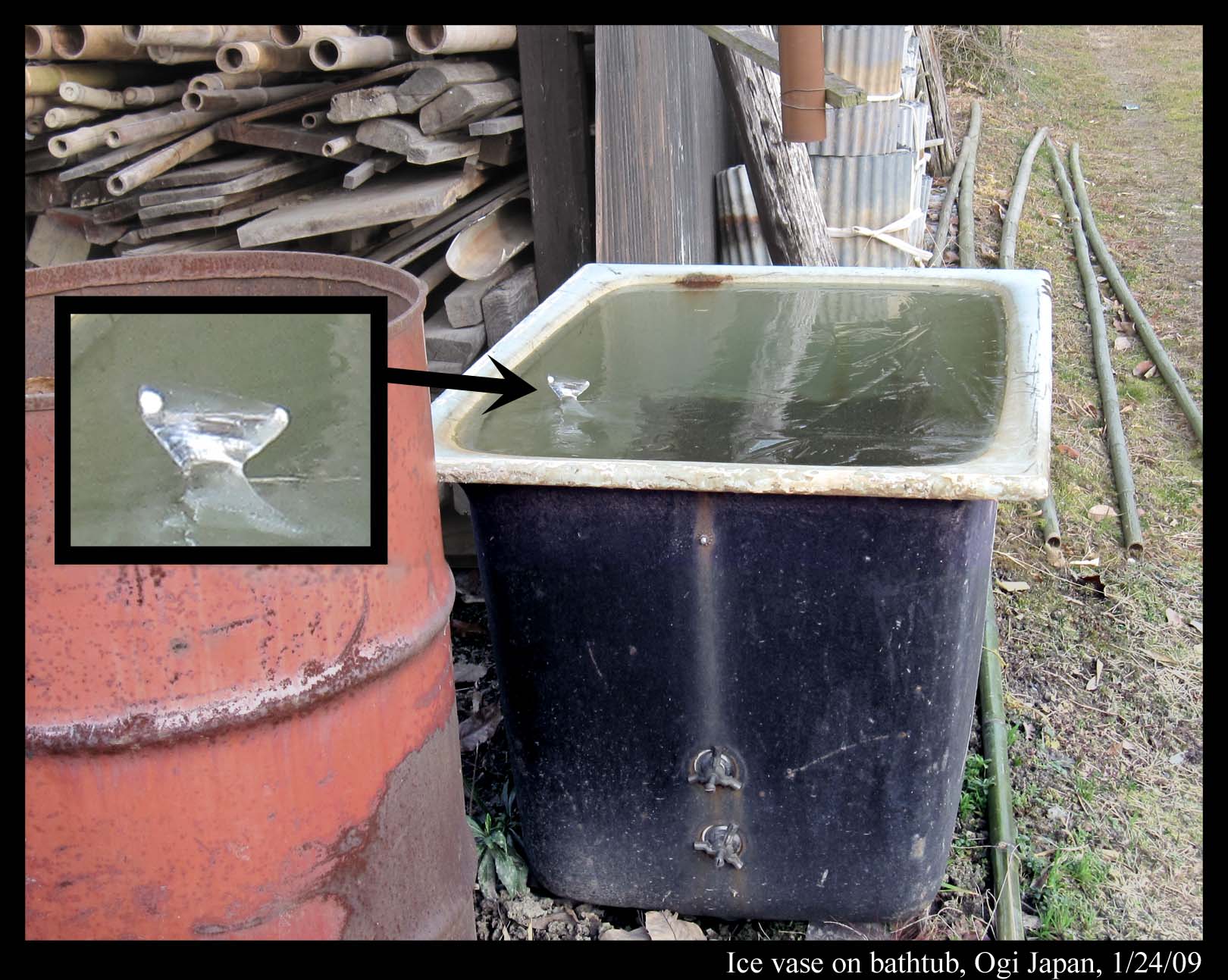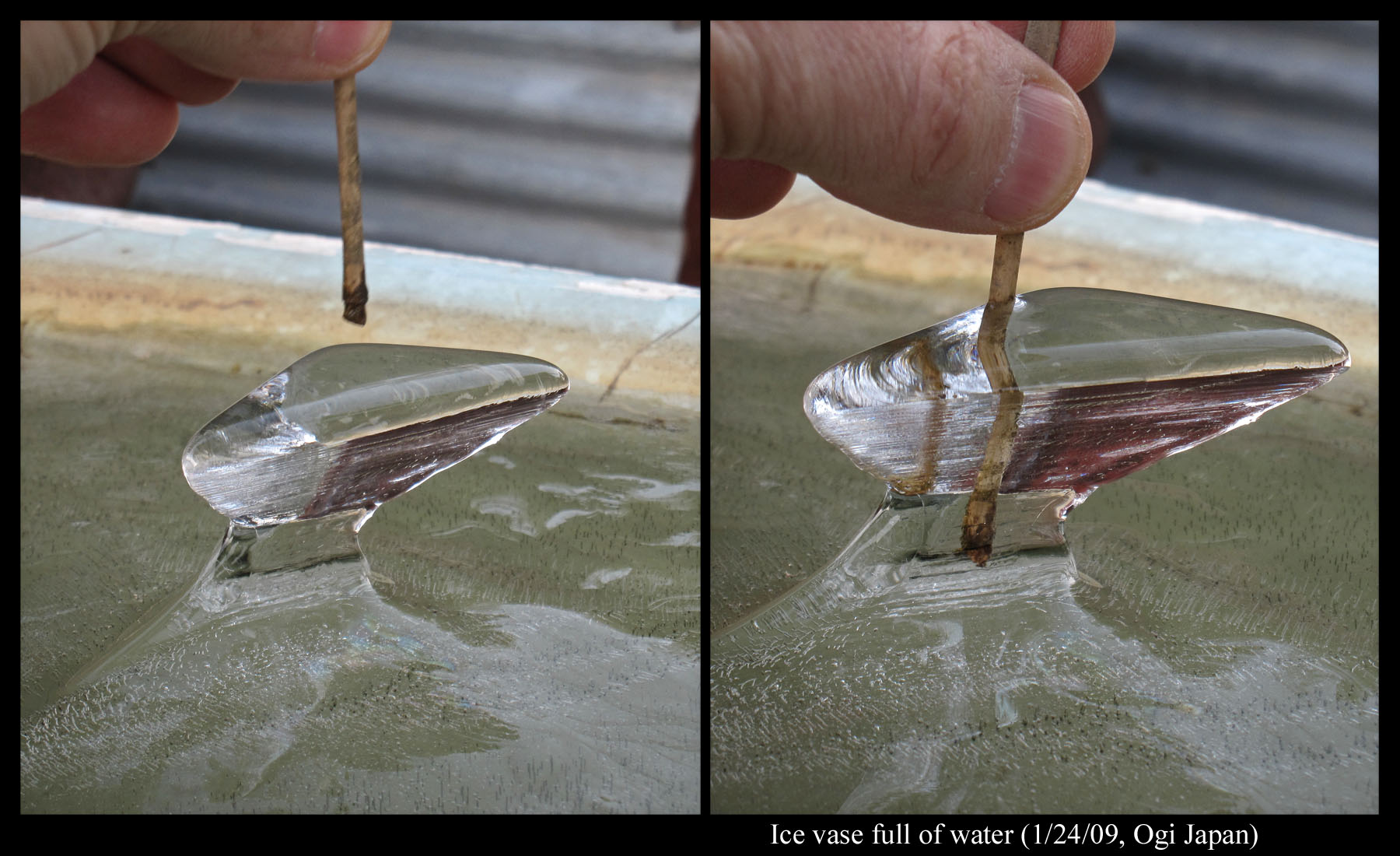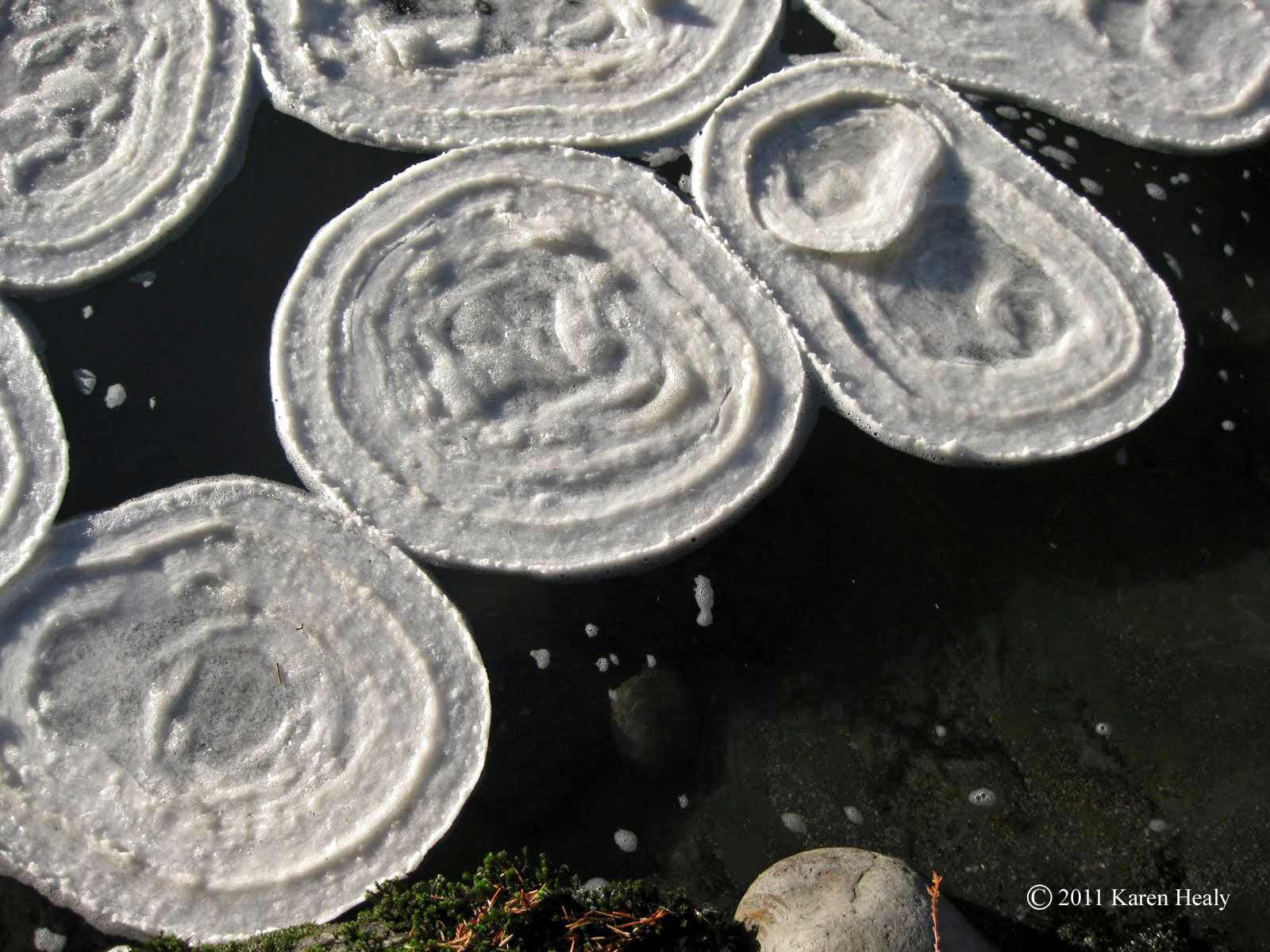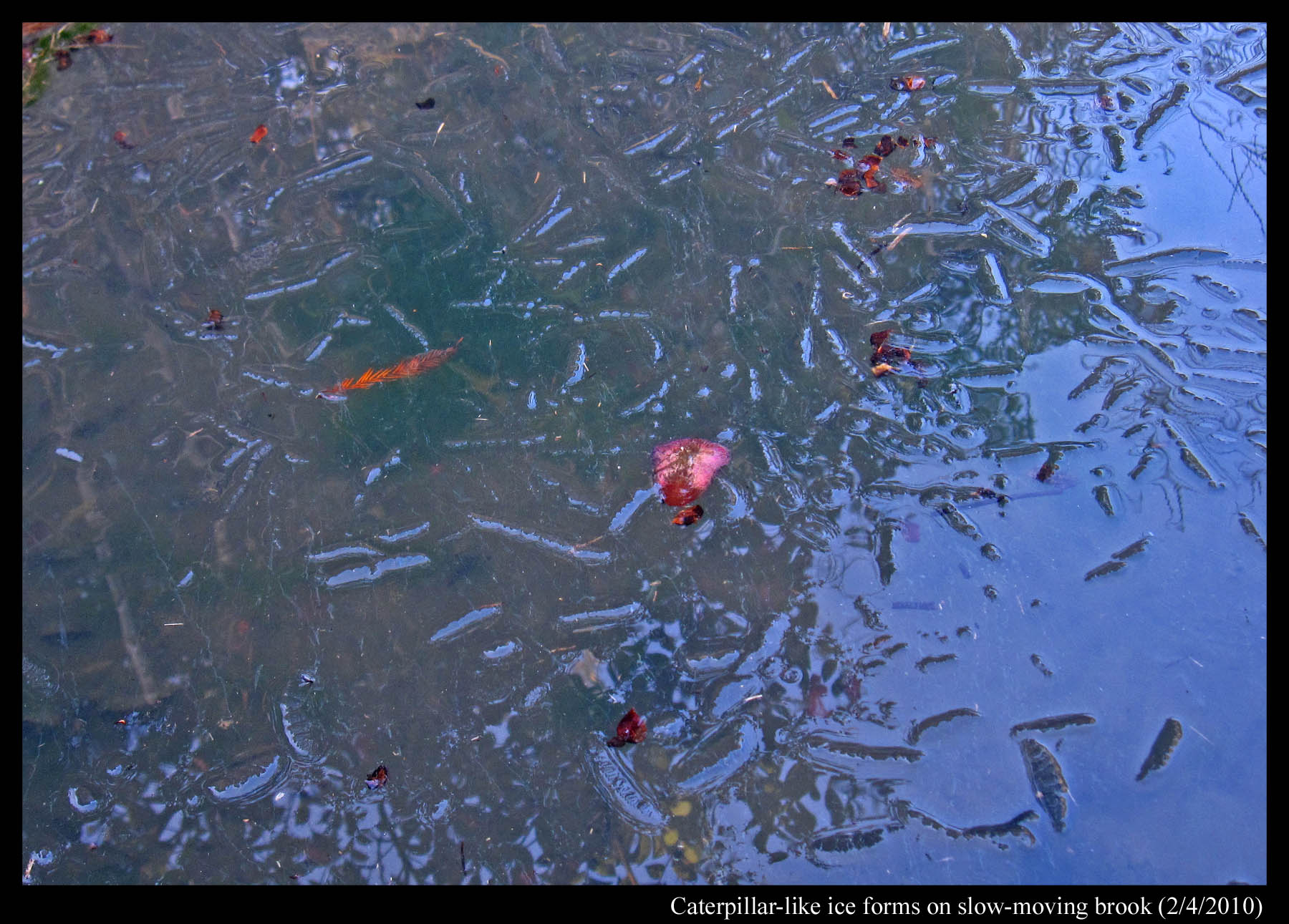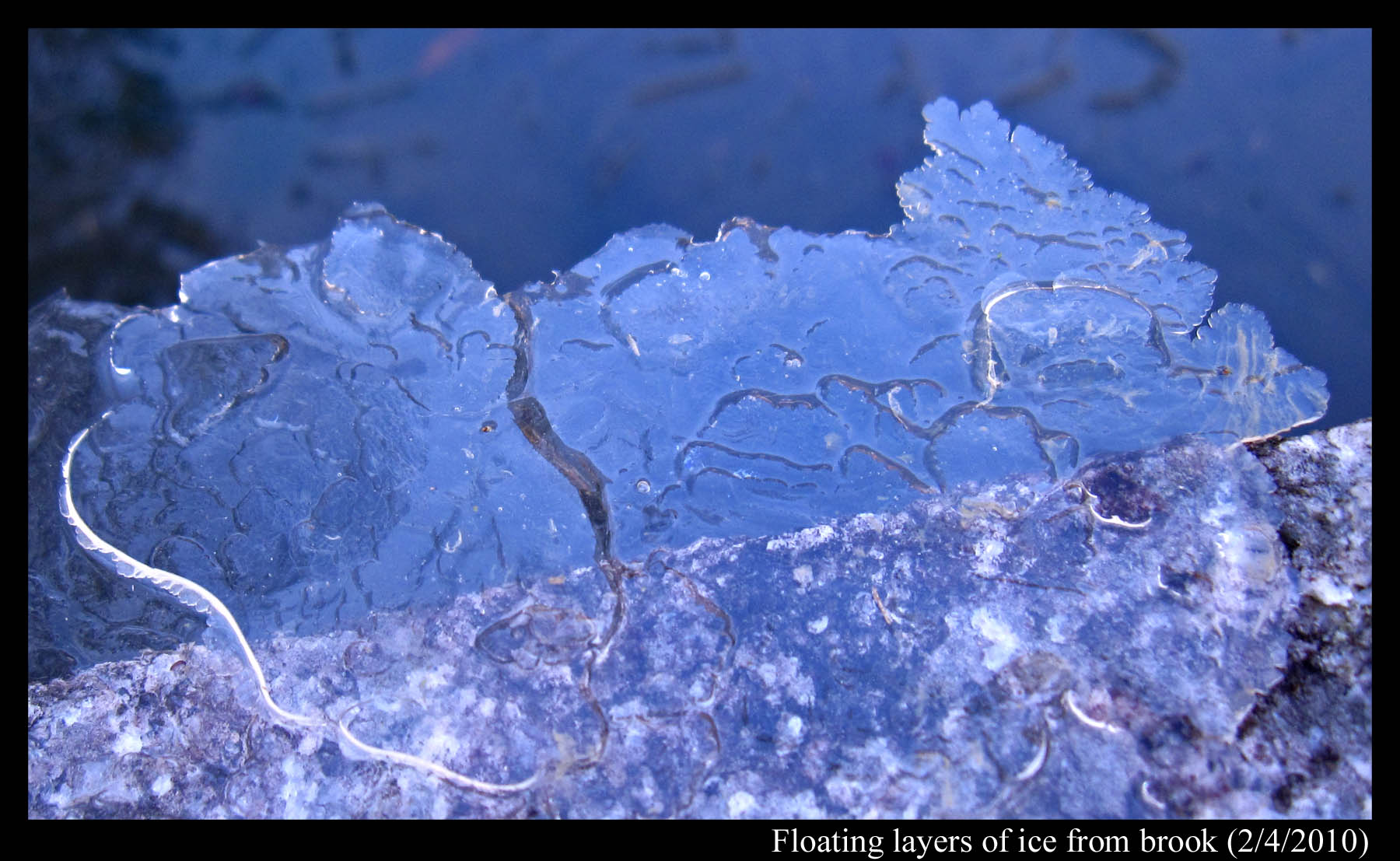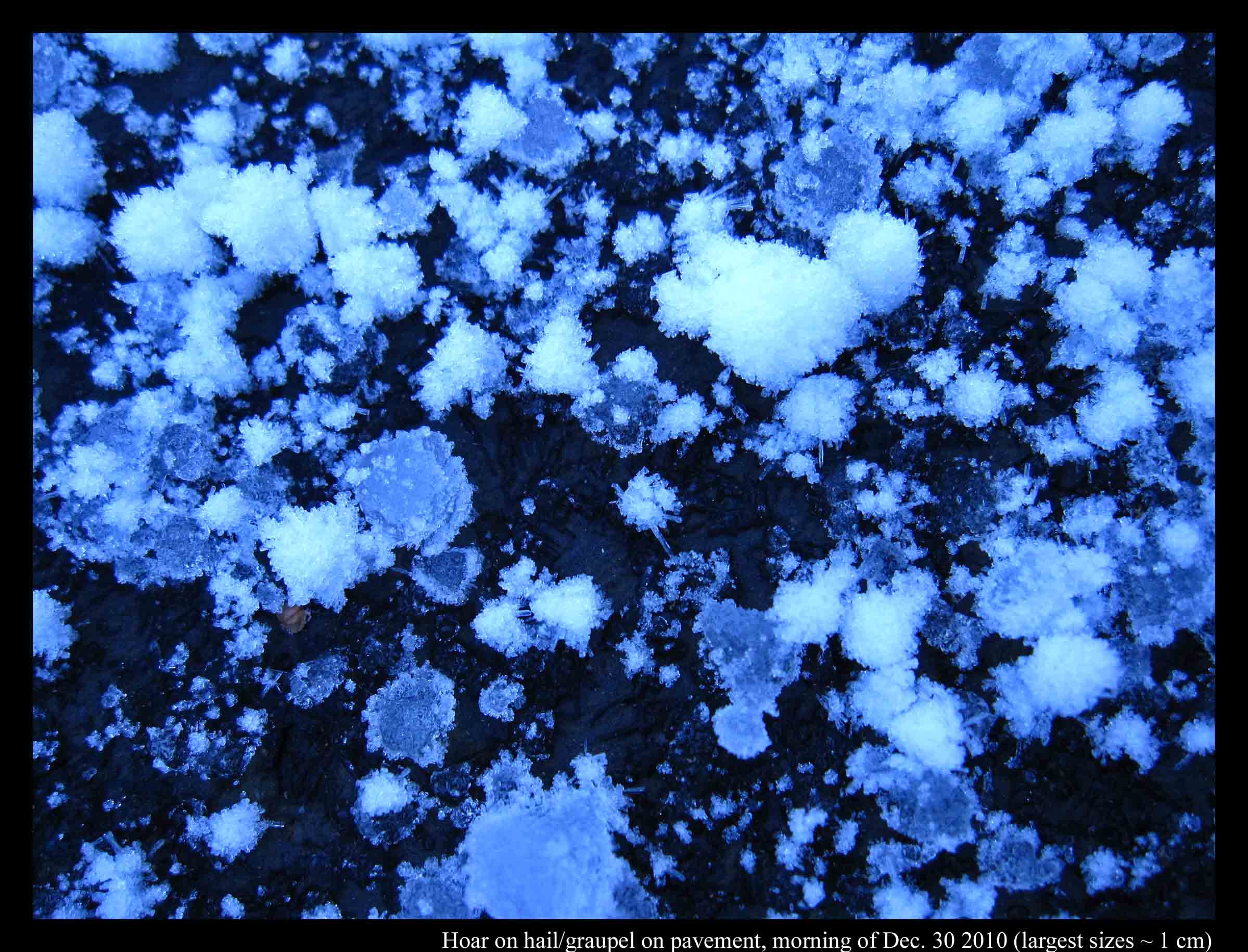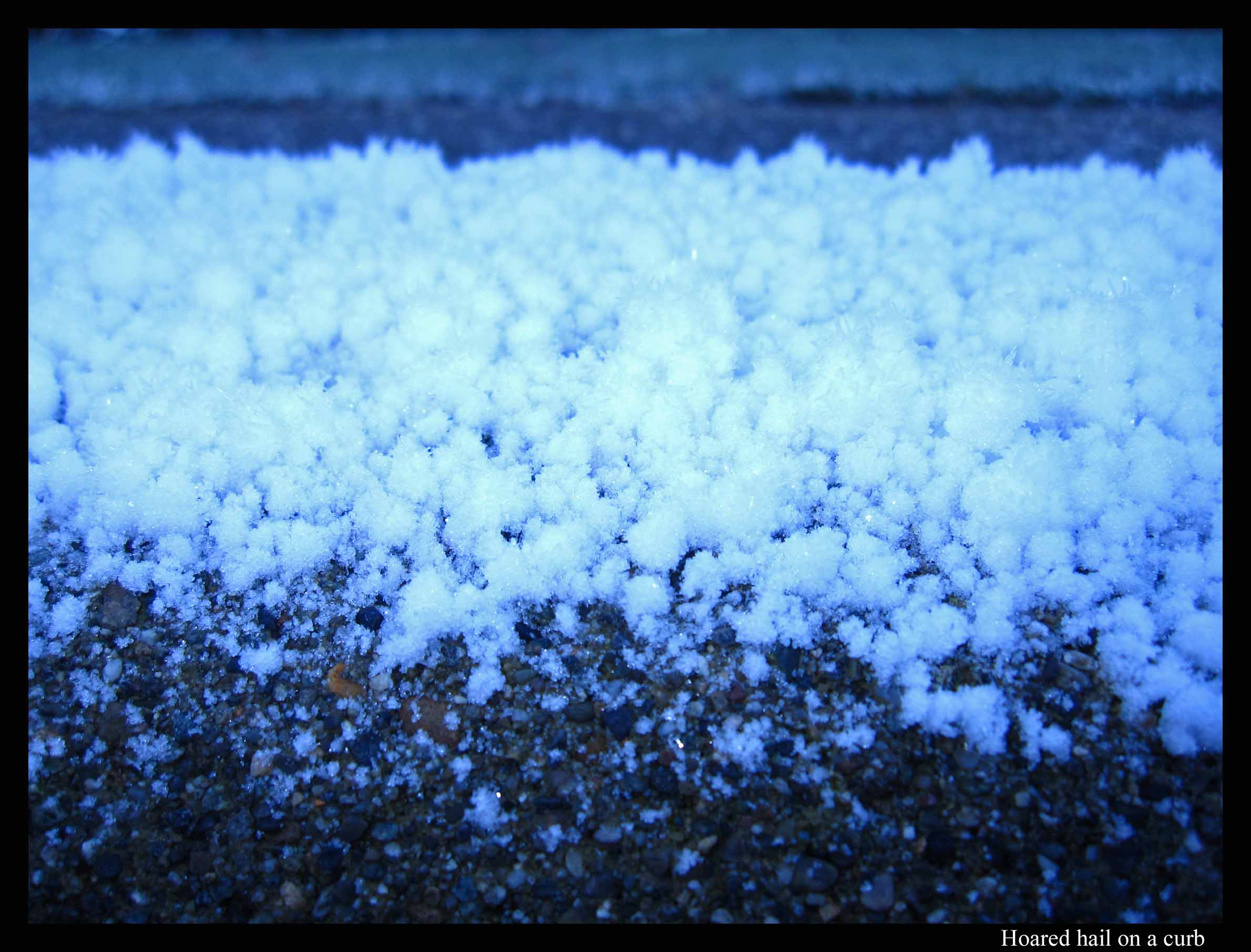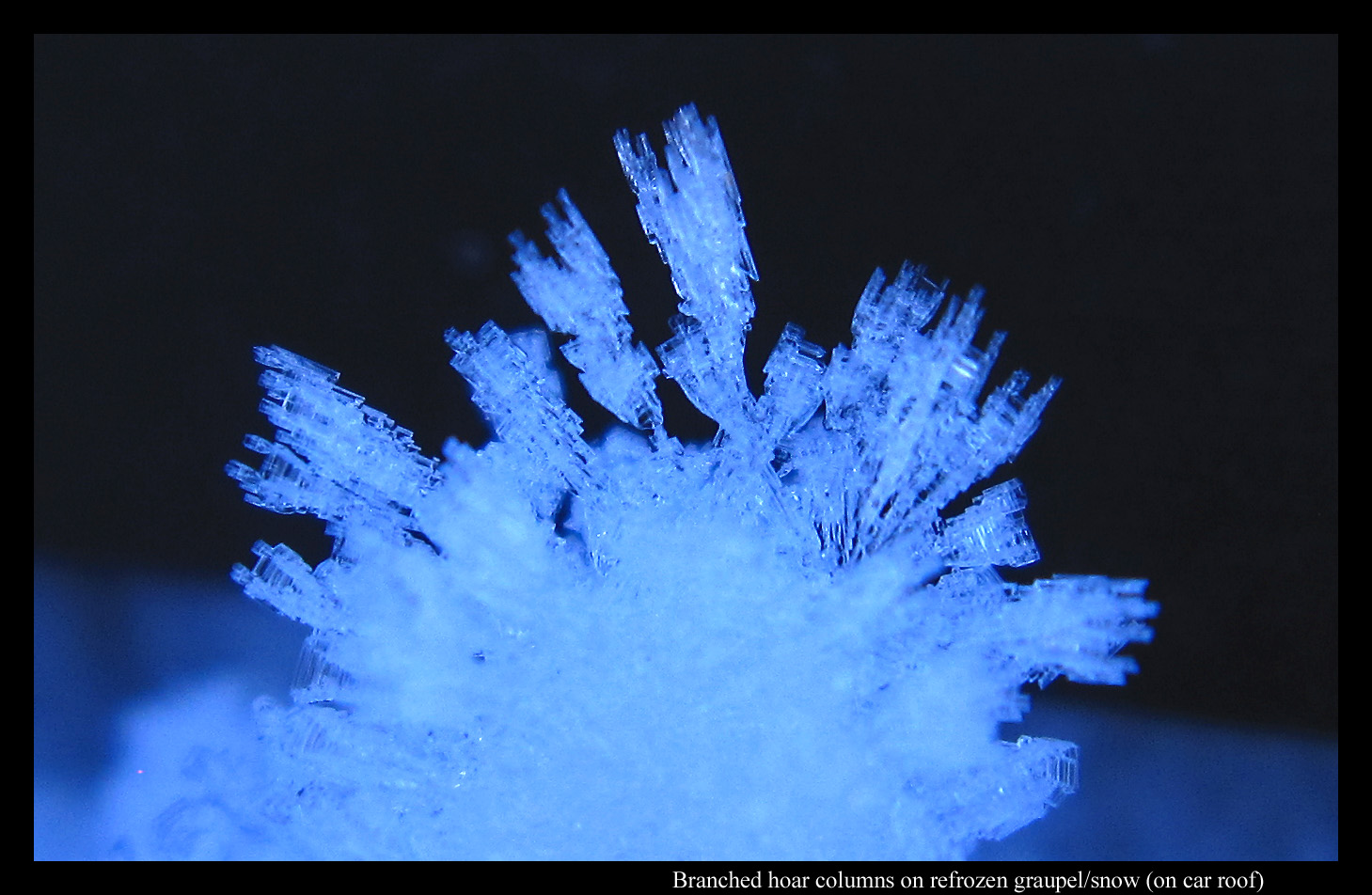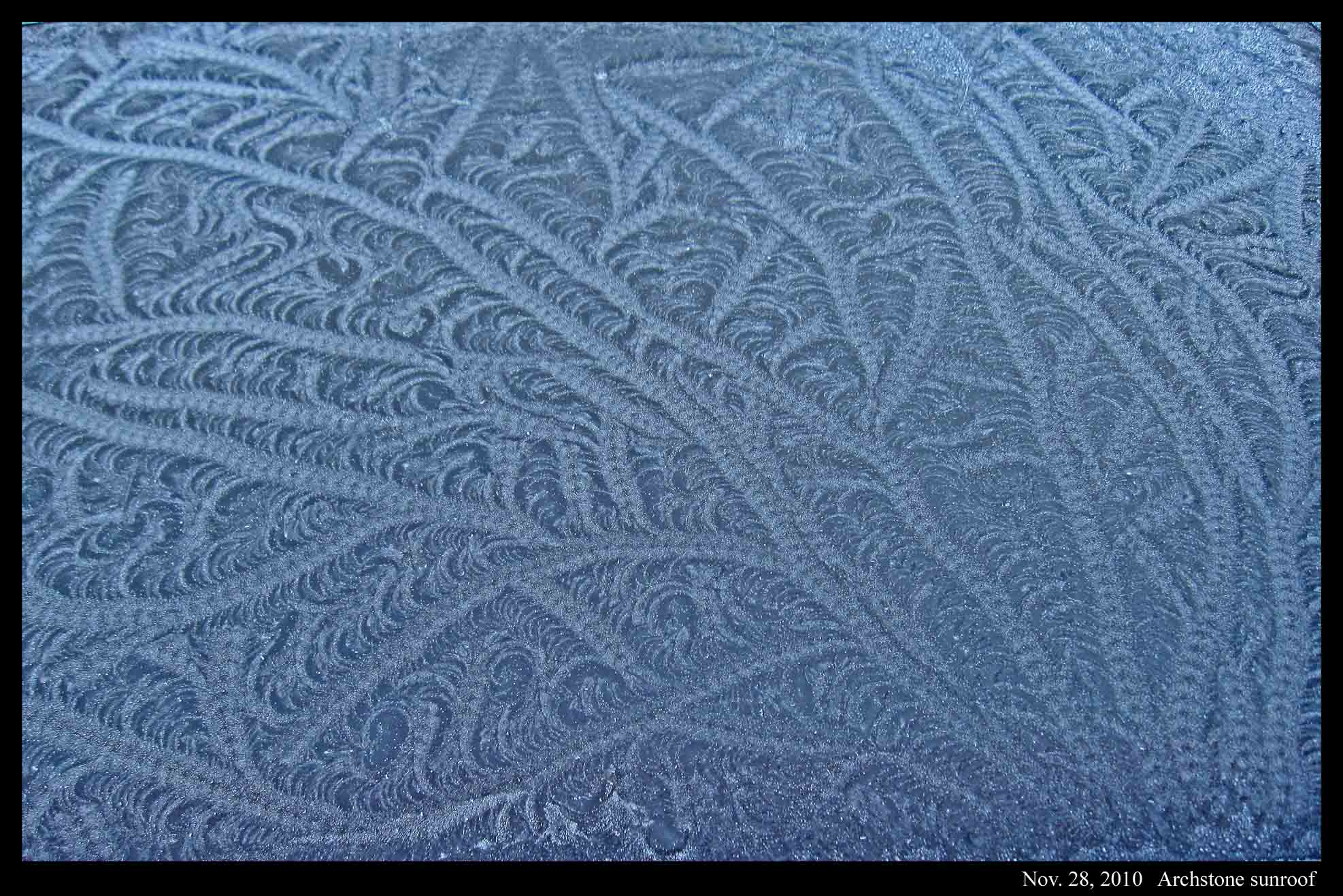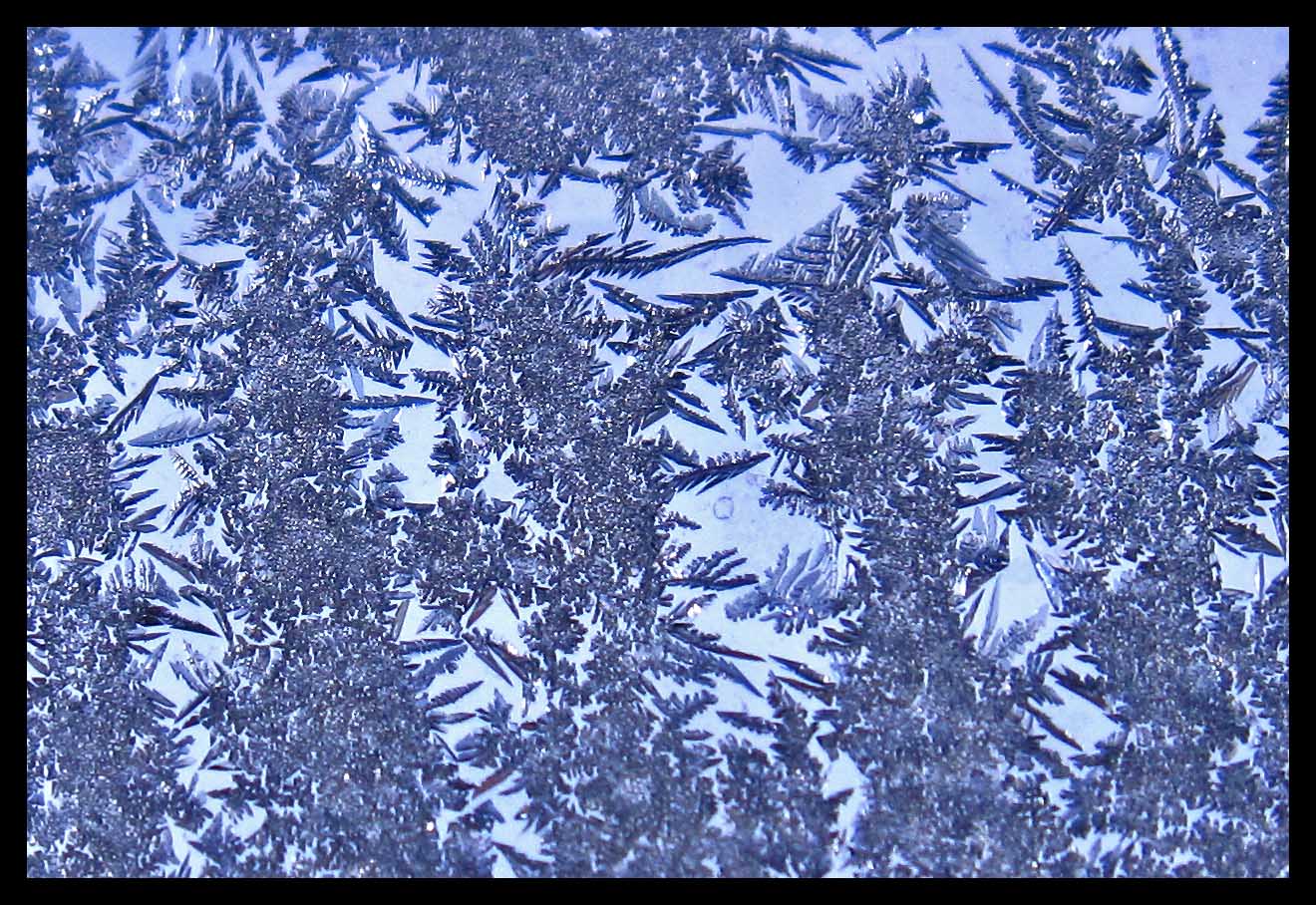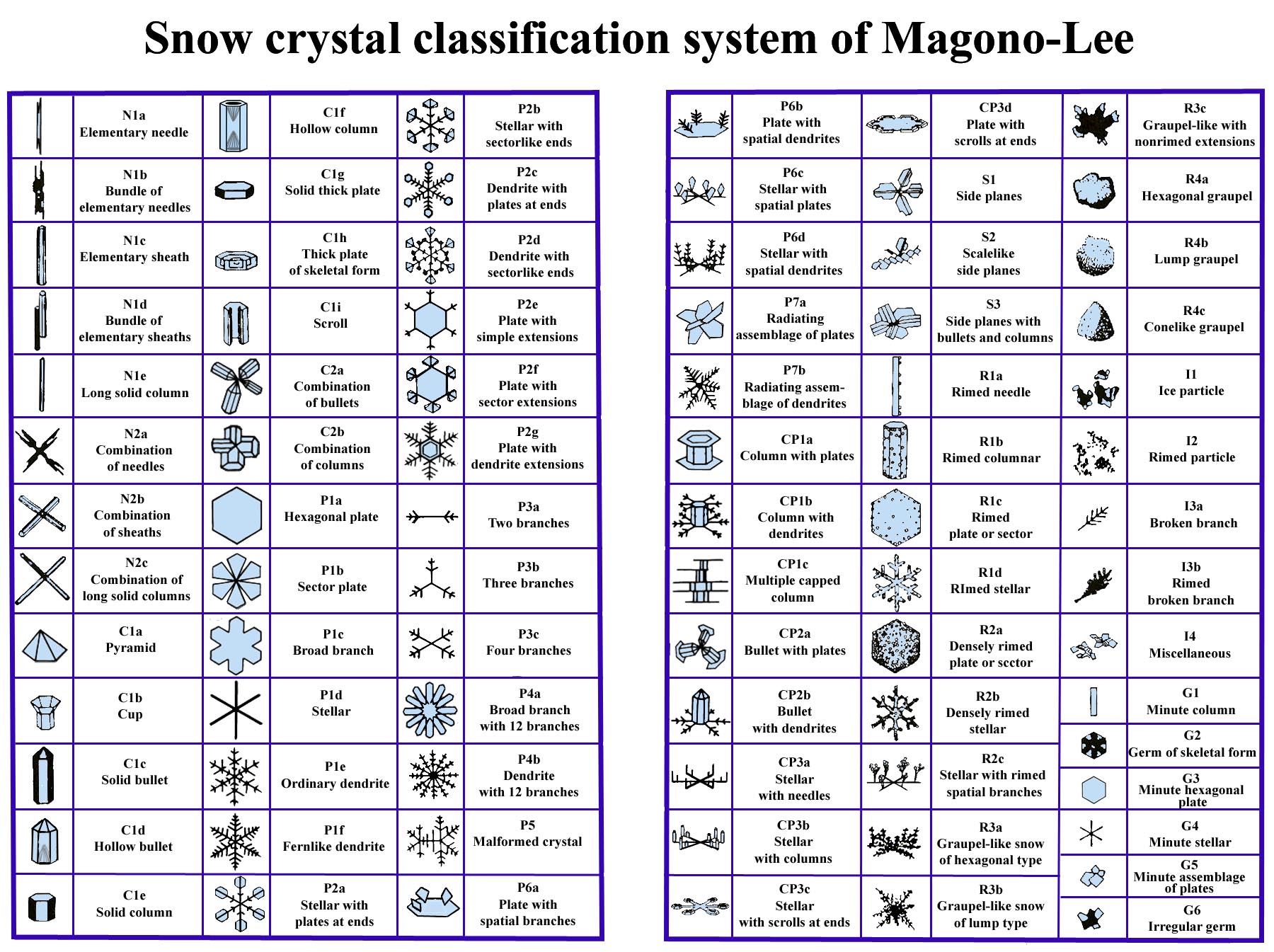Choppy waves
January 11th, 2012I thought this hoar frost pattern looked like rough seas. I see choppy, cusp-like waves down there.
Not having any pictures of rough seas, I hopped in our bathtub and kicked my legs around to make waves. Perhaps you can see a little resemblance.
However, the processes that caused the cusp-like, choppy wave pattern in the frost are completely different from those in the bathtub. Look more closely at the hoar-frost pattern:
It just goes to show you that hoar frost is never as simple as you’d think. Though from a distance it might look like white whiskers, up close it shows unexpected patterns. These patterns reveal something about how the crystals strained, twisted, and competed with each other.
Though it is true that the hoar crystals we see are built of deposited vapor molecules (invisible water molecules once floating in the air that happened to strike and freeze onto a cold surface), the story of hoar has an earlier beginning. In the beginning, the surface already had a thin film of liquid water. See the top panel in the sketch below.
The Six-fold Nature of Snow
March 15th, 2011How the crystal got its “six”
What We Sometimes Miss
March 8th, 2011For the first few years in which I would excitedly go out on frosty mornings to photograph ice formations, I never paid any attention to frost on car bodies. Sometimes I would notice something on our car window, but that was basically it – I was essentially blind to ice in places where I didn’t expect to see anything interesting. Then one day, while returning from an area that often had fascinating puddles and ground ice, I walked next to a black car with the most stunning display of frost that I had ever seen. The car was completely covered roof, hood, and trunk with a thick, large, curvy white pattern of ice made distinct by the background of black underneath.
I spent the next hour or so taking pictures, returning home once to get another camera when my roll of film ran out. Though I understood roughly the processes involved, the initial freezing of a thin layer of water, making curvy ice patterns, followed by vapor depositing onto the frozen parts as hoar, making the ice white, there were other puzzling things that kept me entertained. However, the most puzzling thing of all was the fact that people would walk right by without even slowing down. Here was a strange and rare sight: strange because of the hastily dressed man (myself) leaning over a parked car with a tripod snapping pictures, and a rare yet striking display of curving frost in full view, and yet they paid me nor my prize no mind. It was as if I was the only person who could see the pattern.
The reverse thing happened to me just a few days ago. We had wet weather one day followed by a cold, clear night – perfect conditions for good hoary film frost. And indeed, many cars in our parking lot had beautiful curvy film-frost. I walked around, looking specifically for black cars, which show the most contrast to the white hoar, and photographed some on one car, but somehow overlooked the most amazing one of all: a speckled-seaweed-like pattern that I've seen only once before (see the Dec. 1 posting).
Even though the above was on a black car in a region I checked, I still missed it. But luckily, my neighbor caught it and emailed a few photos. In the image, some of the trails seem to cross over each other, but closer inspection instead suggests a coincidental merging of two trails on one side with a forking off on the other side.
An Ice Vase Sprouts From a Bathtub
February 6th, 2011Someone recently sent me a beautiful image of an ice structure in the shape of a vase. The vase in that case had somehow sprouted out of a frozen birdbath. The thing reminded me of an ice vase I once found on an old plugged-up bathtub in a farmer’s field in Japan. See the photo below.
On approaching the tub, I first thought the ice bump on top was some chunk that had fallen off the roof and refrozen. But on closer view, I found that the thing had sprouted out of the surface. How did I know? Well, as I leaned over it, my body pressed against the tub wall, and I noticed something move. Turned out it was water on top, filling up the vase to the brim! See the sequence below.
Clearly, I’m not pushing that flimsy twig through solid ice.
Of all the curious things I’ve seen here, never before nor since did I see something like this water-filled ice vase. However, the vase forms in much the same way as the somewhat-more-common “ice-cube spikes” that sprout from ice cube trays. But how do such spikes and vases form?
Ice Forms on Slow-moving Water II: Pancakes and Frozen Foam
January 16th, 2011An acquaintance of mine recently discovered these odd discs of ice.
The discs floated freely in an eddy behind some fallen logs on the Nooksack River’s south fork. See other photos and a short video at
http://picasaweb.google.com/karenhealy11/January12011IceFloes#5557968238304251890
What we think happened is this: Foam floating about on the water, which you can see in the video, started to freeze, probably at night. Bits of frozen foam got pushed around in the eddy, and in the ensuing collisions, became roughly circular. Perhaps each disc grew radially when smaller pieces of unfrozen foam struck the disc, adhered and spread out a bit along the perimeter, and then froze in place.
The raised rims are undoubtedly due to the collisions. One sees such rims on “pancake ice”, which is also said to be due to collisions, but what about the concentric raised regions inside the discs? None of the images of pancake ice on Google seem to show these inner lines.
Here’s an idea about those lines. The air temperature oscillated during the growth of these discs: colder at night due to the clear-sky conditions and resulting radiative cooling, but warmer in the day. The discs may have grown at night, collecting new foam, then during the day, when the discs softened in the sun, softening particularly around the edges, the collisions raised up the rims. The next night, further radial growth followed by a new rim the next day at a greater radius. The pictures and video show 4-5 such rims, indicating growth over 4-5 days, which is roughly consistent with the duration of our cold snap.
- JN
Ice Forms on Slow-moving Water I: Caterpillars and Cellular Dendrites
January 15th, 2011During my last winter in Japan (2009-2010), I would walk around a neighborhood park on frosty mornings, looking for interesting ice forms. It was in this park that I found one rock (only one!) that on some mornings would sprout hair-like ice, arising from liquid water within (see the last images in my “Ice on the Rocks” post, Jan 27). This park also has a small, slow-flowing brook that, despite the relatively warm conditions, often freezes over. Usually, upon freezing, it shows an ice pattern consisting of many long (~ one foot) straight lines – a typical pattern you usually see on glaciated puddles and ponds. But on the morning of February 4, at one spot right before the water tumbled over a waterfall, the ice surface looked slightly different. It had lines, but the lines were short, thick, and bumpy (see photo below), looking a bit like black-blue caterpillars scattered about.
From the small bridge spanning the brook, I reached down, pulled some ice out, and was shocked at what I saw. This was not “solid” ice, but rather a bunch of very thin ice plates loosely resting on each other – somewhat like a deck of cards spread out in a fan, though in this case, each ice plate had its own size and shape. Also, unlike other thin ice plates I’d seen before, these ones resembled neither the fast-growing ice dendrites (the snow-crystal-like, branched forms) nor the slow-growing ice discs. The photo below also shows that the plates were big – the section shown being several inches across.
Over larger streams and faster-moving water, ice can develop into something called frazil ice. I’ve no experience with frazil ice, never having lived in a cold-enough region, but I this caterpillar ice may be different. For one, the water was extremely slow-flowing. I could not discern the flow, even in ice-free regions, whereas the descriptions I’ve read about frazil ice involve easily discernable flow rates, flow rates that introduce turbulence, crystal collisions, and mixing below the surface. Also, the ice crystals I saw were much larger than the millimeter-sized pieces I see reported for frazil ice. So, the caterpillar form might be a transitional form, between frazil and that over stagnant water.
Hoared Hail and Coraline Cups
December 31st, 2010As far as I could tell, nobody had predicted hail last night, yet there it was on the ground, the largest hail I’ve ever seen here in the northwest. It fell on wet ground, freezing to the surface and then growing hoar columns, making the ground white and crunchy.
The parking lot in front of our apartment was covered in ice, mostly clear (i.e., "black") ice, yet, because of the ice lumps, it was not slippery under my boots. I kept expecting to slip, but never did. On the curb, where it was a little colder, the hoar was much thicker, looking like an inch of snow.
Same story for the tops of cars, where it had been coldest. The temperature was such that the hoar was mainly columnar. Columnar hoar, indeed all hoar, grows just like snow – when an excess of water molecules deposit from the vapor – and yet columnar hoar tends to develop more in the “cup” (C1b) and “scroll” (C1i) forms (see my Feb. 14 posting for the meaning of the symbols).
But unlike the pencil-like columnar forms of falling snow, these cups and scrolls grow broader at their growing end, even branching out into a pattern a bit like coral.
And if you look closely at the above shot, you will see that the “branches” grow along the same axis as the crystal from which they sprout. (For the above shot, I put a piece of black cloth in back to show the boundaries more clearly.) Such branching contrasts with that for tabular crystals, such as the ones on the familiar six-branched snow crystal.
Why do the columns widen at their growing ends, thus making a cup-shape, why do the cup rims sometimes curl into scrolls, and why do they branch out? I suspect the reason for all three (though not a complete reason) is that the humidity next to the growing crystals is very high – higher than that surrounding the typical column form that drops from the sky. Unlike the latter case, where the humidity is too low for the prismatic faces to grow outward, at least at any rate near that of the basal, here both the basal and prismatic faces grow at comparable rates. Such growth behavior also depends on the temperature, for reasons that still elude us.
- JN
More Tales of Mystery and Observation
December 1st, 2010When I stepped out early Saturday morning, the air seemed relatively warm, particularly compared to the cold snap we had last week. Indeed, it was much warmer, and yet the parking lot in our apartment complex had a glaze that was much more dangerous than that during the cold snap.
But it was the frost that I noticed. Of course, the air was relatively warm, but the clear sky cooled the surface. Recently, snow melted, leaving plenty of open water to evaporate – perfect conditions for film frost and hoar.
I saw “striped-tail” film frost(1) on two car roofs, both times on the sunroof glass. Why only on the glass? Perhaps the glass, being a poorer conductor of heat, had a lower surface temperature. This lower temperature would have produced a thicker film of water, and the thickness of the film seems to influence the pattern. The bigger mystery though is the cause of the pattern. In a short online article(2) last year, I suggested a cause for the stripes on each tail, though I can offer no explanation for either the nearly uniform width of the tails or the meandering. In the case below, the pattern is dense with lazily wandering striped tails. When I look at it, I think of seaweed. The metal car surfaces often had nice curving film-frost with dense hoar, while others had or condensed droplets with more isolated, spiky hoar. The latter appeared on my own car.
The Window of Many Cacti
February 14th, 2010The resemblance may be a bit more obvious in the following shot, which I took two years ago on seeing this form for the first time.
How to classify snow crystals
February 14th, 2010According to Edward LaChapelle’s Field Guide to Snow Crystals (1969), the most widely used classification for falling ice is a system of 10 types from the International Commission on Snow and Ice, which came out in 1951. A few years later, ice researcher Ukichiro Nakaya published a new system with four times the number of ice types. The number doubled 12 years later in 1966 when Magono and Lee published an extension of Nakaya’s system. Of all systems, I think Magono and Lee’s classification of 80 types gets the most use nowadays, so I show it here to help make more people aware of it.
To classify a crystal, you simply look at the table below and find the example that most nearly resembles your crystal. This table is a scanned copy of the one in LaChapelle’s book, with some markings cleaned up and a little color added. Click on it to enlarge.
For example, the crystal in Mark's Feb. 14 posting is P1c, a broad-branch crystal.
The number 80 seems large, but even this system has notable omissions. Magono and Lee include graupel (R4a, R4b), which are crystals that collided with many supercooled droplets, but they exclude crystals that collided with and adhered to other crystals. That is, they exclude snowflakes. Other omissions include distinct forms like the spearhead and seagull types as well as sub-divisions of forms they do include; for example, plates like P1a except with unequal sides such as the oft-sited trigonal forms (alternating prism faces are shorter/longer), and hollow columns like C1f except with hollows on all faces. And although they include 12-branched crystals, they don’t include 18 and 24-branched forms. They probably had a good reason for excluding these forms, but it would be nice to have a more complete table for the avid naturalist to refer to.
Choji Magono was a professor of geophysics at Hokkaido University in Sapporo Japan, and C. W. Lee was his student. I’ve known about other work by Magono for some time, but I’ve never found any other publications by Lee. I recently asked about Lee to someone who once was a student there, and he told me that Lee returned to North Korea soon after getting the PhD, apparently never to be heard from again. It sounds like a sad ending for a once very promising young researcher. If you can read this Lee, here’s a big thanks for your great dissertation work.
- JN
